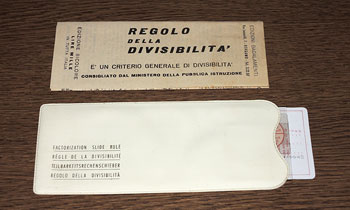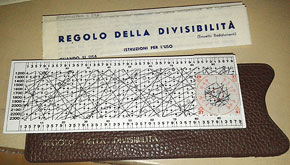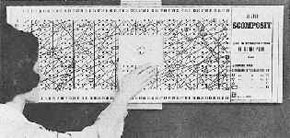 |
 Up
Up
|
|

|

|
Badalamenti’s factorization slide rule |
|
|
|
|
Here is a very unusual device – the only mechanical calculator I’ve seen that tackles the problem of factoring a number. That is, given a number, it tells you its prime factors – the unique set of prime numbers whose product it is (unless it is itself prime, which the device then points out). The number being factorized can be up to 3199, so this tool is no danger to today’s cryptographic algorithms, which rely on the difficulty of factorizing numbers with hundreds of digits; still, it’s a cool tool! |
|
|
|
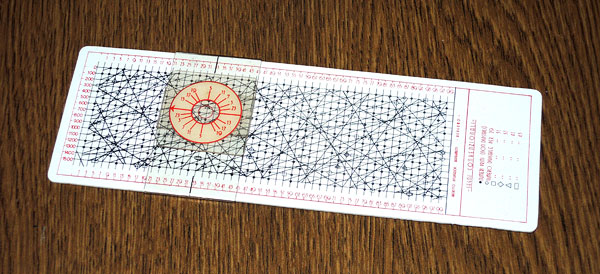 Click photo to enlarge |
|
|
|
The calculator consists of a small rule of
white plastic 16.1 x 5.4 cm, with a complicated cursor sliding along
it. The cursor has a “bull’s eye” that can be moved up and down it
vertically, while the cursor itself moves right and left; thus the
bull’s eye can be made to point at any location on the rule.
Specifically, you can make it point at any of the points on a two
dimensional grid, each of which represents a single odd number (for
even numbers the user is expected to first manually divide by 2
until an odd number is attained). The calculator actually has two usable sides – one for factoring numbers from 3 to 1599 and the other for the range 1601 to 3199. You need to slide off the cursor, reverse it and slide it onto the other side to change from one range to the other. |
|
|
|
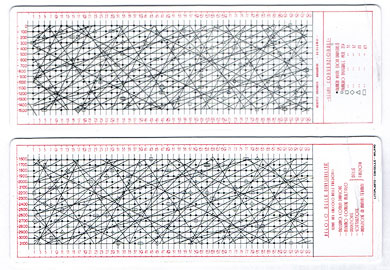
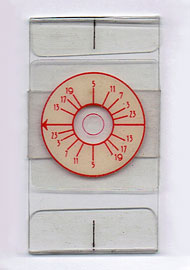 Click a photo to enlarge |
|
|
|
Here’s how this works: You move the cursor
until its bull’s eye is centered on the grid point representing the
number to be factored. This number is indicated by the sum of a y
coordinate (indicated by the arrow on the left of the cursor, and
read off the scale on the left of the rule, indicating a multiple of
100) and an x coordinate (read under the black hairlines at the top
or bottom of the rule). Next you examine what happens at the
selected grid point. If it shows a black dot, it is a prime and
you’re done. If it is crossed by one or more lines of varying
slopes, you look their meaning up on the cursor; the slope of each
line corresponds to a prime factor between 3 and 23, and you can see
which it is by aligning the line on the grid with the red line
segments on the cursor. Prime factors above 23 are indicated by tiny
geometrical figures surrounding the grid point, whose legend is seen
at the end of the rule: a circle means 29, a square means 31, and so
on for 37, 41 and 43. For illustration, here is an example of factoring 1023, into3x11x31: |
|
|
|
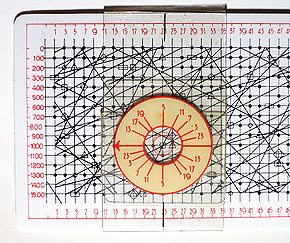
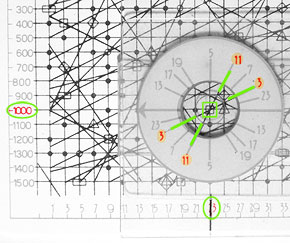 Click a photo to enlarge |
|
|
|
Here are a couple more examples: On the left, 1333=31x43; on the right, 513=19x3x3x3 |
|
|
|
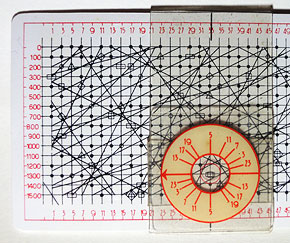
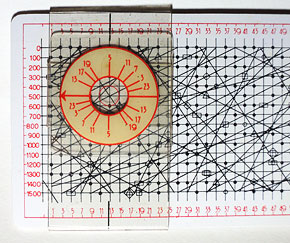 Click a photo to enlarge |
|
|
|
As the last example shows, the rule doesn’t
always show all factors explicitly – here it shows “3” once and lets
you figure that it appears three times in the decomposition. At
other times, say for 2279, it shows only 43 and lets you calculate
by yourself the other factor, 53, which exceeds its display
capability. The instructions cite this as a worthy feature – by not
giving all the factors, they claim, the student is required to think
about the factorization and thus learns better... This fascinating calculator was invented in Italy by Gaetano Roberto Badalamenti of Bergamo. The instructions say he was a mathematician who had discovered the underlying theory in 1957. Badalamenti applied for a patent in Italy in 1958, and in the US in 1959. The US patent was granted on May 8, 1962. The motivation behind this invention seems to have been primarily didactic: to facilitate the study of mathematics in the secondary school system. This is reflected in the instructions, and in the fact that a wall-mounted version (98 x 33 cm) was available for classroom instruction. This last was available under the name Scomposit from a small publishing house – Edizioni Beta, of Rome – that was founded in 1944 by Mr. Badalamenti and was managed by him for decades. The email address on the company’s site – which looks quite dated – is dead, and one can assume that the company (and possibly its founder) is no longer around. |
|
|
|
The calculator evidently had at least two pocket models as well as the classroom version (below, right). My friend Nicola Marras has a version(below, left) that is shorter than mine, because the legend has been moved to the corners of the bull’s eye cursor -- an excellent idea. |
|
|
|
|
|
|
Exhibit provenance: eBay, from a seller in Italy. More info: |
|
|
|
|
|
|
|
Home | HOC | Fractals | Miscellany | About | Contact Copyright © 2019 N. Zeldes. All rights reserved. |
|
